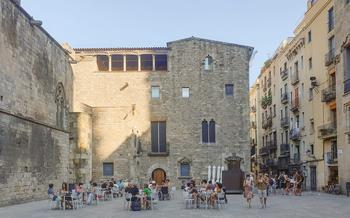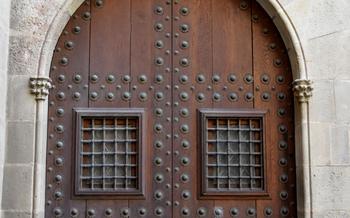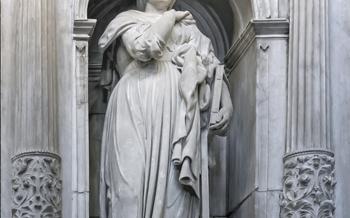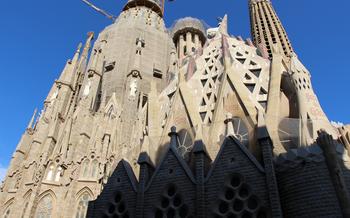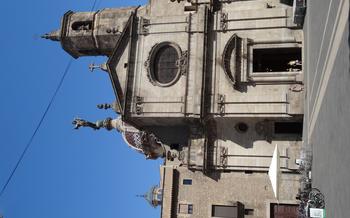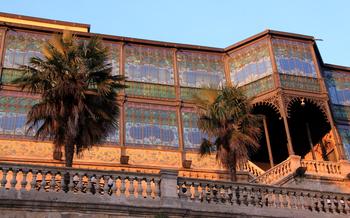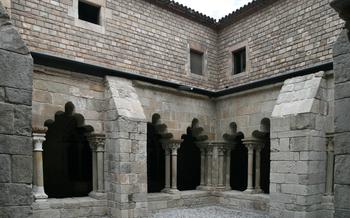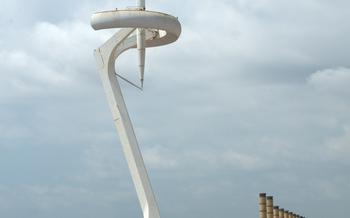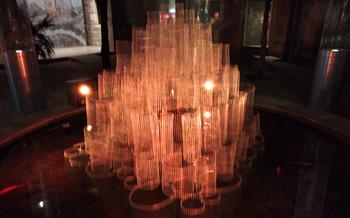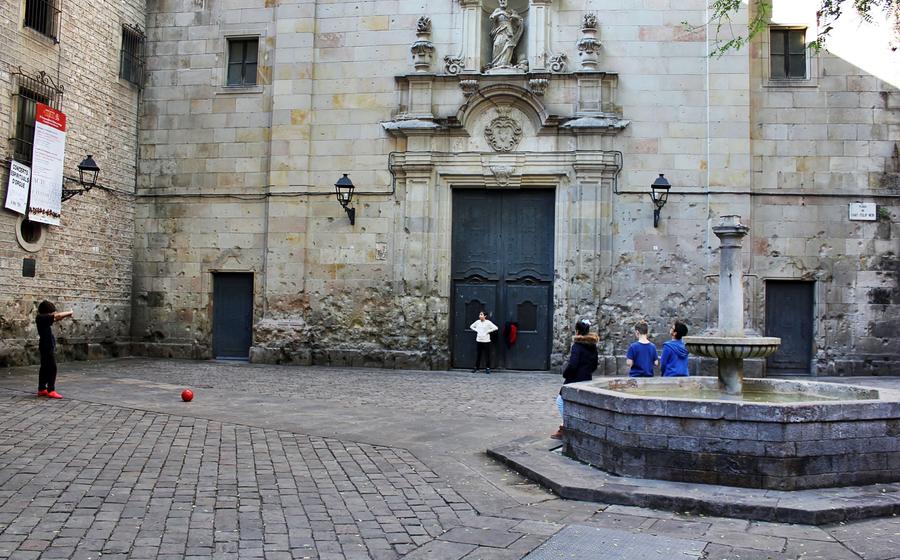
Sant Felip Neri Square
- Sant Felip Neri Square: A Symbol of Resilience
- Location: In the Heart of the Gothic Quarter
- History: From Church to Square
- Architecture: A Unique Blend of Styles
- The Church of Sant Felip Neri: A Sacred Legacy
- The Miraculous Statue of the Virgin Mary
- The Square Today: A Vibrant Community Space
- The Bullet Holes: A Reminder of the Past
- The Olive Tree: A Symbol of Peace
- The Sant Felip Neri Market: A Culinary Delight
- Visiting Tips: Making the Most of Your Visit
Sant Felip Neri Square: A Symbol of Resilience
In the heart of Barcelona's Gothic Quarter, amidst the labyrinthine streets and medieval marvels, lies a square that stands as a poignant symbol of resilience and renewal. Sant Felip Neri Square, once the site of a beloved church, bears the scars of a tragic event that shook the city during the Spanish Civil War. Yet, from the ashes of destruction, it has risen as a vibrant community space, a testament to the indomitable spirit of Barcelona and its people.
The square's history is etched into its very fabric, a tale of destruction and rebirth. The Church of Sant Felip Neri, which once graced the square, was reduced to ruins by a merciless aerial bombardment in 193The attack, carried out by the forces of General Francisco Franco, left an indelible mark on the city, claiming countless lives and destroying cherished landmarks.
In the aftermath of the war, the people of Barcelona embarked on a monumental task of reconstruction. With determination and a profound respect for their heritage, they meticulously restored the square, preserving its historical essence while incorporating elements of modernity. Today, Sant Felip Neri Square stands as a testament to their resilience and unwavering commitment to preserving their city's legacy.
Location: In the Heart of the Gothic Quarter
The Sant Felip Neri Square is conveniently located in the heart of the Gothic Quarter, one of Barcelona's most charming and historic neighborhoods. The exact address is Plaça Sant Felip Neri, 1. The square is easily accessible by public transportation, with the Jaume I metro station just a short walk away. Several bus lines also stop nearby.
The Sant Felip Neri Square is surrounded by a wealth of other attractions, making it an ideal starting point for exploring the Gothic Quarter. The Barcelona Cathedral, with its Gothic spires and intricate façade, is just a stone's throw away. Other nearby highlights include the Picasso Museum, the Santa Maria del Mar Basilica, and the Palau de la Generalitat, the seat of the Catalan government.
History: From Church to Square
The Sant Felip Neri Church was constructed in the 18th century, replacing an earlier Romanesque church that stood on the same site. The new church was designed in a Baroque style, featuring an ornate façade and a spacious interior with a central nave and side chapels. It quickly became a beloved landmark in the Gothic Quarter, serving as a place of worship and community gathering for generations of Barcelonians.
However, tragedy struck on March 30, 1938, during the Spanish Civil War. The church was targeted by an air raid by the Nationalists, who dropped three bombs on the building. The impact of the bombs was devastating, causing the roof and much of the interior to collapse. The church was reduced to a pile of rubble, with only the façade and a few fragments of the walls still standing.
In the aftermath of the war, the people of Barcelona were determined to rebuild their beloved church. However, the task was daunting, as the damage was extensive and resources were scarce. It took many years of hard work and dedication before the church was finally restored to its former glory.
In 1954, the church was deconsecrated and transformed into a public square. This decision was made in order to create a more open and inviting space for the community. The square was named after the church that once stood there, and it has since become a popular gathering place for locals and visitors alike.
Architecture: A Unique Blend of Styles
The Sant Felip Neri Square showcases a harmonious blend of architectural styles that reflects Barcelona's rich history and cultural influences. The square's predominant Gothic elements can be seen in the pointed arches, ribbed vaults, and intricate stone carvings that adorn the surrounding buildings. These Gothic features, reminiscent of medieval times, lend a sense of grandeur and historical depth to the square.
Baroque influences, characterized by their elaborate ornamentation and dramatic curves, are also evident in the square's architecture. The Church of Sant Felip Neri, with its ornate facade and intricate interior, stands as a testament to the Baroque style's grandeur and opulence.
In addition to these historical styles, the square also exhibits touches of Modernism, a movement that emerged in Barcelona in the late 19th and early 20th centuries. Modernist elements, such as the use of curved lines, floral motifs, and colorful tiles, can be seen in some of the buildings and decorative elements around the square.
The overall aesthetic of the Sant Felip Neri Square is one of harmonious coexistence between different architectural styles. The Gothic, Baroque, and Modernist elements blend seamlessly, creating a unique and captivating cityscape that transports visitors to different eras of Barcelona's history.
The Church of Sant Felip Neri: A Sacred Legacy
The Church of Sant Felip Neri, a once-magnificent edifice, stood as a testament to Barcelona's rich religious heritage. Its construction began in the 17th century, blending Gothic and Baroque architectural elements to create a masterpiece of sacred architecture. The church's interior was adorned with intricate frescoes, ornate altars, and a majestic pipe organ, showcasing the artistry and devotion of its creators.
However, the church's fate took a tragic turn during the Spanish Civil War. In 1938, a relentless bombardment by Franco's forces reduced the church to a skeletal ruin, its once-vibrant interior reduced to rubble. The loss of this sacred space was a devastating blow to the local community, who had cherished the church as a place of worship, solace, and community gatherings.
Despite the destruction, the spirit of Sant Felip Neri remained unbroken. After the war, a wave of hope and resilience swept through the community. The people of Barcelona, determined to honor their heritage and rebuild their beloved church, embarked on an ambitious reconstruction project.
With the combined efforts of skilled architects and the unwavering support of the community, the church began to rise from the ashes. While preserving the original Gothic structure, the reconstruction incorporated modern elements, blending the past and present in a harmonious dialogue of architecture. The result was a stunning testament to the indomitable spirit of Barcelona, a city that had endured unimaginable hardships but emerged stronger and more resilient.
Today, the Church of Sant Felip Neri stands as a poignant reminder of the city's resilience and its unwavering commitment to preserving its cultural heritage. Visitors to the church can admire its restored Gothic façade, adorned with intricate carvings and sculptures. The interior, while simpler than its pre-war grandeur, still exudes a sense of serenity and spirituality.
Masses are regularly held in the church, providing an opportunity for the local community to gather and worship in the sacred space that their ancestors fought to rebuild. The Church of Sant Felip Neri, a symbol of faith, resilience, and the enduring power of community, continues to hold a special place in the hearts of Barcelonians.
The Miraculous Statue of the Virgin Mary
Amidst the devastation of the bombing, a glimmer of hope emerged when a statue of the Virgin Mary was discovered intact amidst the ruins of the church. The statue, known as the Virgin of Sant Felip Neri, had stood in the church for centuries and was deeply revered by the local community. Its survival was seen as a miracle and a symbol of resilience.
The statue was carefully recovered and placed in a temporary shrine, where it quickly became a pilgrimage site for people seeking solace and hope in the aftermath of the tragedy. The Virgin of Sant Felip Neri became a symbol of the community's unwavering faith and their determination to rebuild their lives and their city.
Today, the statue is housed in the newly reconstructed Church of Sant Felip Neri, where it continues to be a source of inspiration and devotion for visitors from all over the world. Its presence in the square serves as a reminder of the suffering endured by the people of Barcelona during the Spanish Civil War, and their remarkable ability to rise from the ashes and rebuild their lives.
The Square Today: A Vibrant Community Space
Today, Sant Felip Neri Square stands as a vibrant and bustling community space, a testament to the resilience and spirit of Barcelona. The square is a popular gathering spot for locals and tourists alike, who come to enjoy its unique atmosphere and attractions.
The square is home to a variety of activities and events throughout the year. On weekdays, the square is a lively market, where vendors sell fresh produce, local delicacies, and handmade crafts. On weekends, the square transforms into a cultural hub, hosting concerts, dance performances, and art exhibitions.
The square also plays an important role in the local community. It is a place where people come to socialize, relax, and celebrate. The square is often used for community gatherings, such as picnics, barbecues, and festivals.
Sant Felip Neri Square is a symbol of Barcelona's spirit. It is a place that has witnessed both tragedy and triumph, and it has emerged from adversity as a stronger and more vibrant community. The square is a reminder that even in the face of great challenges, the human spirit can prevail.
The Bullet Holes: A Reminder of the Past
As you explore Sant Felip Neri Square, you'll notice several bullet holes etched into the walls of the surrounding buildings. These poignant marks are a physical reminder of the tragic bombing that took place in 1938 during the Spanish Civil War. Each hole represents a life lost, a story untold, and a testament to the resilience of the Catalan people.
The bullet holes serve as a stark reminder of the horrors of war and the devastating impact it had on Barcelona. They are not merely relics of the past, but active symbols of the city's enduring spirit and its ability to rise from adversity.
Beyond their historical significance, the bullet holes also hold educational value. They offer a tangible connection to a pivotal moment in Spanish history, inviting visitors to reflect on the consequences of conflict and the importance of peace.
These bullet-scarred walls stand as silent witnesses to the resilience of Barcelona, a city that has repeatedly faced challenges but has always emerged stronger. They are a powerful reminder of the human cost of war and the indomitable spirit of the Catalan people.
The Olive Tree: A Symbol of Peace
In the heart of Sant Felip Neri Square, a majestic olive tree stands tall, its gnarled trunk and verdant leaves a testament to its enduring strength. This tree is not just an ornamental feature; it holds deep symbolic significance for the people of Barcelona.
The olive tree, or "olivera" in Catalan, is a revered symbol of peace, resilience, and longevity in Catalan culture. Its roots run deep into the region's history, mythology, and traditions. In Sant Felip Neri Square, the olive tree stands as a reminder of the community's ability to overcome adversity and rebuild after the devastation of the Spanish Civil War.
The tree was planted in the square in 1985, coinciding with the 50th anniversary of the end of the war. It was a conscious act of reconciliation and a symbol of hope for a peaceful future. The olive tree has since become an integral part of the square, a gathering place for locals and visitors alike.
During the annual Plaça Sant Felip Neri Festival, the olive tree is adorned with colorful ribbons and decorations, transforming it into a symbol of celebration and joy. The tree also plays a role in community gatherings and events, serving as a focal point for shared experiences and stories.
Beyond its symbolic meaning, the olive tree in Sant Felip Neri Square is a living reminder of the importance of nature and the environment. In a city that is constantly evolving, the tree stands as a guardian of the past and a symbol of hope for a sustainable future.
The Sant Felip Neri Market: A Culinary Delight
Amidst the historical significance and architectural beauty of the Sant Felip Neri Square, a delightful culinary experience awaits visitors at the Sant Felip Neri Market. This vibrant market, located just steps from the square, offers a feast for the senses, immersing visitors in the rich flavors and aromas of Catalan cuisine.
The market's stalls are a treasure trove of local delicacies, from fresh produce and artisanal cheeses to cured meats and traditional sweets. Visitors can indulge in a mouthwatering array of tapas, sample regional wines, and savor the flavors of freshly baked pastries. The market is also a haven for olive oil enthusiasts, offering a wide selection of extra virgin olive oils from local producers.
The atmosphere in the market is electric, with locals and tourists alike bustling about, eager to discover the culinary delights on offer. The air is filled with the sounds of laughter, chatter, and the sizzling of paella pans, creating a truly immersive experience.
For those seeking a taste of authentic Catalan cuisine, the Sant Felip Neri Market is an absolute must-visit. Whether you're looking for a quick bite to eat or a leisurely lunch break, the market offers something for every palate. So, come hungry and prepare to indulge in the culinary wonders of Barcelona at the Sant Felip Neri Market.
Visiting Tips: Making the Most of Your Visit
To fully appreciate the beauty and significance of Sant Felip Neri Square, plan your visit during the spring or autumn months when the weather is pleasant. Dedicate at least an hour to explore the square, allowing time to admire its architecture, visit the church, and soak in the atmosphere.
For a comprehensive experience, start your visit with the church of Sant Felip Neri, marveling at its interior features and learning about its history. Then, step outside to explore the square, paying attention to the bullet holes and the serene presence of the olive tree. Take a moment to pause and reflect on the square's symbolic importance as a testament to resilience and hope.
If time permits, visit the Sant Felip Neri Market, where you can immerse yourself in the vibrant local culinary scene. Sample traditional Catalan dishes, savor fresh produce, and engage with the friendly vendors.
To delve deeper into the square's history and cultural significance, consider joining a guided tour. These tours often provide fascinating insights into the events that shaped the square and its enduring legacy.
For those with limited mobility, the square is easily accessible by wheelchair, ensuring an inclusive experience for all visitors.
